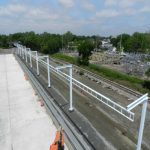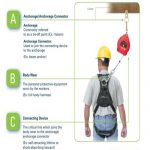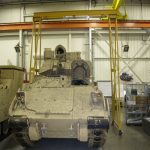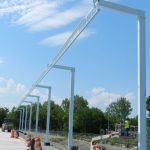Continued Blog: Hierarchy of Fall Protection – Fall Arrest Systems
 In this blog, we will discuss the 4th and last option on the hierarchy of fall protection. Fall Arrest Systems are last on the hierarchy of Fall Protection because the system and equipment are designed to arrest a fall. Basically, if a fall occurs the system will prevent/arrest the worker from falling to his death or a serious injury. Fall Arrest Systems are also known as Personal Fall Arrest Systems because each employee is equipped with the proper PPE-personal protective equipment combined with a system or anchorage designed to arrest a fall with an acceptable force and clearance margins.
In this blog, we will discuss the 4th and last option on the hierarchy of fall protection. Fall Arrest Systems are last on the hierarchy of Fall Protection because the system and equipment are designed to arrest a fall. Basically, if a fall occurs the system will prevent/arrest the worker from falling to his death or a serious injury. Fall Arrest Systems are also known as Personal Fall Arrest Systems because each employee is equipped with the proper PPE-personal protective equipment combined with a system or anchorage designed to arrest a fall with an acceptable force and clearance margins.
The ABC’s of Fall Arrest Systems
 Fall Arrest Systems consist of anchorage, body wear, and a connecting device also known as the ABC’s of Fall Protection. Rigid Track Systems, Horizontal Lifelines, Vertical Lifelines, Single Point Anchors, Cross-Arm Beam Straps are types of anchorages used in Fall Arrest Systems. The other two components of the Fall Arrest System are a harness- body wear and self-retracting lifeline or lanyard-connecting device. An example of a Fall Arrest System is if maintenance work needs to be performed on top of aircraft. A rigid track can be installed above the worker with a harness and self-retracting lifeline the worker can attach to the system and be protected from a fall. The equipment along with the anchorage will arrest a worker in the event of a fall. Employers can best protect their workers by understanding the work being done and then providing solutions.
Fall Arrest Systems consist of anchorage, body wear, and a connecting device also known as the ABC’s of Fall Protection. Rigid Track Systems, Horizontal Lifelines, Vertical Lifelines, Single Point Anchors, Cross-Arm Beam Straps are types of anchorages used in Fall Arrest Systems. The other two components of the Fall Arrest System are a harness- body wear and self-retracting lifeline or lanyard-connecting device. An example of a Fall Arrest System is if maintenance work needs to be performed on top of aircraft. A rigid track can be installed above the worker with a harness and self-retracting lifeline the worker can attach to the system and be protected from a fall. The equipment along with the anchorage will arrest a worker in the event of a fall. Employers can best protect their workers by understanding the work being done and then providing solutions.
Certified and Non-Certified Systems
 As we have discussed in last couple of blogs, fall protection is a case by case basis so depending on the work, access to the work area, frequency of work will determine the design and equipment of the Fall Arrest System. When a Fall Arrest System solution is chosen, it is critical to understand the different types of anchorages, the issues associated with selecting anchorages, design loading requirements, and other important design considerations. Typically, there are 2 types of Fall Arrest Systems- certified and non-certified; and the difference between them is the anchorage and how it is connected to building. The difference between Certified and Non-Certified Systems will be discussed in more detail next month. The type of Fall Arrest System along with the equipment is designed with the employee in mind and the work that is being performed.
As we have discussed in last couple of blogs, fall protection is a case by case basis so depending on the work, access to the work area, frequency of work will determine the design and equipment of the Fall Arrest System. When a Fall Arrest System solution is chosen, it is critical to understand the different types of anchorages, the issues associated with selecting anchorages, design loading requirements, and other important design considerations. Typically, there are 2 types of Fall Arrest Systems- certified and non-certified; and the difference between them is the anchorage and how it is connected to building. The difference between Certified and Non-Certified Systems will be discussed in more detail next month. The type of Fall Arrest System along with the equipment is designed with the employee in mind and the work that is being performed.
The Importance Of These Systems
 The last number of blogs have dealt with the hierarchy of Fall Protection because protecting our workers and returning them home safely is the number one goal. Fall Arrest Systems are designed to just that- return workers home safely- because they arrest a worker from a free fall. Understanding the hierarchy is so important because it allows an employer to make the best decision possible to protect their workers. Once the hazards have been identified and prioritized, they can be systematically abated following the Hierarchy of Controls. FallProof Systems can help in identifying fall hazards and help determine the best solution. In order for employers to protect their workers they need to come up with the best solution- the solution is derived from understanding the hierarchy of Fall Protection.
The last number of blogs have dealt with the hierarchy of Fall Protection because protecting our workers and returning them home safely is the number one goal. Fall Arrest Systems are designed to just that- return workers home safely- because they arrest a worker from a free fall. Understanding the hierarchy is so important because it allows an employer to make the best decision possible to protect their workers. Once the hazards have been identified and prioritized, they can be systematically abated following the Hierarchy of Controls. FallProof Systems can help in identifying fall hazards and help determine the best solution. In order for employers to protect their workers they need to come up with the best solution- the solution is derived from understanding the hierarchy of Fall Protection.

